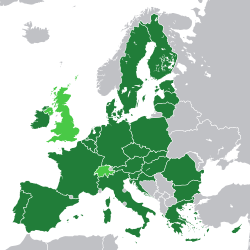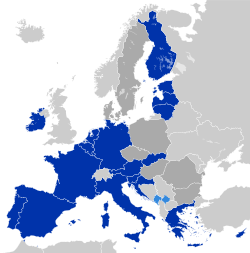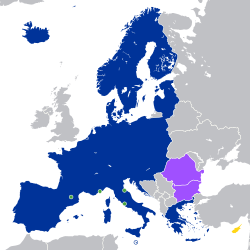This article needs additional citations for verification .(March 2013) |
 The signing ceremony of the Treaty of Lisbon on 13 December 2007 which gave the TFEU its current name | |
| Type | Founding treaty |
|---|---|
| Signed | 25 March 1957 |
| Location | Capitoline Hill in Rome, Italy |
| Effective | 1 January 1958 (1 December 2009 under its current name) |
| Parties | EU member states |
| Depositary | Government of Italy |
| Full text | |
| This article is part of a series on |
 |
|---|
The Treaty on the Functioning of the European Union (TFEU) is one of two treaties forming the constitutional basis of the European Union (EU), the other being the Treaty on European Union (TEU). It was previously known as the Treaty Establishing the European Community (TEC). [1]
Contents
- Provisions
- Part 1: Principles
- Part 2: Non-discrimination and citizenship of the Union
- Part 3: Union policies and internal actions
- Part 4: Association of the overseas countries and territories
- Part 5: External action by the Union
- Part 6: Institutional and financial provisions
- Part 7: General and final provisions
- See also
- References
- External links
The Treaty originated as the Treaty of Rome (fully the Treaty establishing the European Economic Community), which brought about the creation of the European Economic Community (EEC), the best-known of the European Communities (EC). It was signed on 25 March 1957 by Belgium, France, Italy, Luxembourg, the Netherlands and West Germany and came into force on 1 January 1958. It remains one of the two most important treaties in the modern-day European Union (EU).
Its name has been amended twice since 1957. The Maastricht Treaty of 1992 removed the word "economic" from the Treaty of Rome's official title and, in 2009, the Treaty of Lisbon renamed it the "Treaty on the Functioning of the European Union".
Following the 2005 referendums, which saw the failed attempt at launching a European Constitution, on 13 December 2007 the Lisbon Treaty was signed. This saw the 'TEC' renamed as the Treaty on the Functioning of the European Union (TFEU) and, once again, renumbered. The Lisbon reforms resulted in the merging of the three pillars into the reformed European Union. [2]
In March 2011, the European Council adopted a decision to amend the Treaty by adding a new paragraph to Article 136. The additional paragraph, which enables the establishment of a financial stability mechanism for the Eurozone, runs as follows:
The Member States whose currency is the euro may establish a stability mechanism to be activated if indispensable to safeguard the stability of the euro area as a whole. The granting of any required financial assistance under the mechanism will be made subject to strict conditionality. [3]



